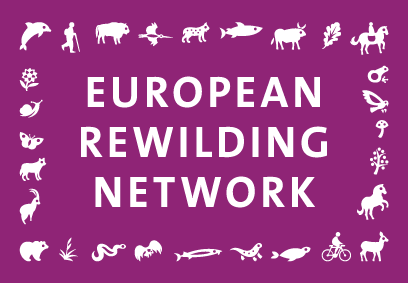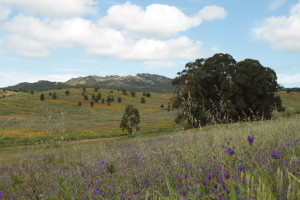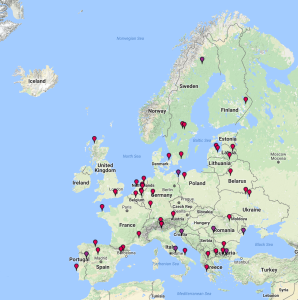Rewilding Europe warmly welcomes three new members into the European Rewilding Network (ERN). These new members are rewilding initiatives from Ukraine, Finland and Portugal. Since its launch at WILD10 in Salamanca in October 2013, the network doubled in size and is now counting 42 members from 22 European countries and eight areas of Rewilding Europe.

 The European Rewilding Network is a living network that connects rewilding initiatives in Europe with the goal to promote rewilding as a conservation approach, through sharing experiences, knowledge and inspiration. Currently, most members are working on large-scale rehabilitation of natural processes in different habitats (such as rivers, forests, mosaic landscapes), development of nature-based enterprises and reintroductions of locally extinct or rare key wildlife species.
The European Rewilding Network is a living network that connects rewilding initiatives in Europe with the goal to promote rewilding as a conservation approach, through sharing experiences, knowledge and inspiration. Currently, most members are working on large-scale rehabilitation of natural processes in different habitats (such as rivers, forests, mosaic landscapes), development of nature-based enterprises and reintroductions of locally extinct or rare key wildlife species.
The three new members are keen to share their expertise and look forward connecting with other members and learn from other initiatives. Rewilding Europe is very pleased to see the growing interest of initiatives from across Europe to participate. The three new members are briefly described below.
Studying large scale wildlife comeback in Chernobyl Exclusion Zone, Ukraine
Thirty years ago, some 100 km north from Kiev, a nuclear disaster changed the lives of many thousands of people and largely affected the European energy debate. What less people know is that the Chernobyl Exclusion Zone (CEZ) – established after the catastrophe – faced a large-scale wildlife come back with species like grey wolves, brown bears, moose and many others. Therefore, beside lessons on energy-safety, Chernobyl teaches us a lot about natural resilience and the recovery of complete ecosystems. For that reason, this spring, the Schmalhausen Institute of Zoology National Academy of Sciences of Ukraine applied for the 207,000 ha CEZ to become a member of the European Rewilding Network. In the zone, research is carried out to study the animals in this abandoned area, giving a unique insight into what nature is capable of after such a tragedy. In addition, in 1998, first Przewalski’s horses were introduced. There are now around 120 wild horses with a steadily growing population. Following this success, there are plans to introduce European bison so that it can naturally maintain this vast area consisting of mixed forests, meadows and mires.
Metamorphosis of Quinta do Pisão Nature Park, Portugal

Quinta do Pisão, part of the Sintra-Cascais Park (Natura 2000 site), is only half an hour drive from Lisbon’s city centre. In 2007, the land was transformed from abandoned agricultural land into an attractive natural park, as well as a working farm. Ecological restoration here focuses on the historical legacy of this rural landscape, including preservation and restoration of natural habitats through natural grazing, reintroducing sustainable farming and close-to-nature forestry and other activities. Nature based tourism and production of local products is part of the project. Amongst many project achievements so far, it is important to mention the transformation of 25 hectares of the fast growing eucalyptus forest into a natural oak forest and the recovery of 55 hectares of natural pastures through natural grazing of native domestic species, such as donkeys, horses and sheep.
After its metamorphosis, the area became a getaway for urban people wanting to reconnect with nature. It currently attracts around 2,000 people each month, mostly coming from the nearby Lisbon metropolitan area. Amongst many activities, visitors can also enjoy in birdwatching, various workshops, trekking, visiting and working in the organic vegetable garden and purchasing local products.
Community-led ecological restoration in Jukajoki river basin, Finland
In North Karelia, boreal Finland, a novel approach of community-led ecological restoration is ensuring water can flow freely again in the Jukajoki basin, once intensely damaged by peat mining activities. In addition, there is a huge challenge connected to impact of climate change. Historic temperatures of 37˚C noticed in 2010 were followed by extreme rainfall. The impact from anthropogenic activities have been devastating; waters became highly acid and fish were dying massively in 2010-2011. Local fishermen took matters into their own hands since authorities kept silent. In 2011 this resulted in a restoration plan that takes into account historical data and traditional knowledge about the area to set a baseline for the ecological restoration of the entire watershed. Collaborative management of villagers, fishermen, hunters and conservationists is the key in this process. Restoring spawning sites for brook trout and Atlantic salmon is one of the important goals.

The Linnunsuo wetland is a central part in the restoration work, now acknowledged as an important bird area as there is a variety of waterbird species coming back. The region is also home to different mammal species like wolverine, moose and brown bear. With the increase of the number of annual visitors to the area, sustainable wildlife watching activities are extending the tourism season and is providing a new source of income to the local community. This autumn the project gave a presentation at the ERN webinar allowing members to learn in detail about the projects progress and future plans.
The European Rewilding Network aims to actively share information, knowledge, experience on restoration and rewilding work throughout the continent, and stimulate cooperation to help the rewilding moving forward. To date, the network comprises of 42 members whose rewilding activities spread over 1,4 million hectares all over Europe. Together with the Rewilding Europe areas, which are now eight, the total number of ERN members is 50, covering some 6,2 million hectares.
Rewilding Europe is encouraging inspiring rewilding initiatives to apply for membership. For more information on how to apply, see here.
